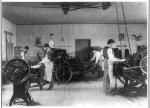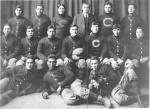![header=[Marker Text] body=[This school was the model for a nation-wide system of boarding schools intended to assimilate American Indians into mainstream culture. Over 10,000 indigenous children attended the school between 1879 and 1918. Despite idealistic beginnings, the school left a mixed and lasting legacy, creating opportunity for some students and conflicted identities for others. In this cemetery are 186 graves of students who died while at Carlisle. ] sign](kora/files/1/10/1-A-228-139-ExplorePAHistory-a0h5d8-a_450.jpg)
Mouse over for marker text
Name:
Carlisle Indian Industrial School
Region:
Hershey/Gettysburg/Dutch Country Region
County:
Cumberland
Marker Location:
North side of Claremont Road, 50 feet east of the Carlisle Barracks, Carlisle
Dedication Date:
August 31, 2003
Behind the Marker
By the 1870s, most white Pennsylvanians considered Indians a distant, dying people, making a doomed last stand on the Great Plains. While a small community of Seneca Indians still lived within Pennsylvania's borders on the Cornplanter Tract in Warren County, most Pennsylvanians considered Indians historical artifacts, a reminder of the state's settlement in the colonial era.
Warren County, most Pennsylvanians considered Indians historical artifacts, a reminder of the state's settlement in the colonial era.
That situation changed abruptly in 1879, when Colonel Richard Henry Pratt, an officer in the U.S. Army, took over the Carlisle Barracks in Cumberland County to create an Indian school. With a single-minded pursuit of his vision of Indian education, Pratt recruited students from across the United States, reversing a century-long trend in Pennsylvania's Indian depopulation.
About 10,000 students attended the Carlisle School from its founding until it closed its doors in 1918, representing more than seventy different tribes. While the vast majority of these students stayed in Pennsylvania for only a year or two, their collective sojourn at Carlisle once again made Pennsylvania a crucible of Indian-white relations in North America.
Pratt had served in the American Civil War and then as a commander of African-American cavalry troops in the Plains Indian wars. In 1875, he was placed in charge of a group of Plains Indian prisoners held at a military prison in Fort Augustine, Florida.
Not content to watch his prisoners die slowly of disease, malnutrition, and the elements, Pratt decided to train them for life in white America by stripping them of their Indian heritage and culture. He took as his model federal schools that were operating at that time for former slaves in places like Hampton, Virginia, where he took some of his Indian students. In 1879 Pratt successfully petitioned the federal government to expand on his experiment by converting the old army barracks in Carlisle, Pennsylvania, into a boarding school.
Pratt summed up his educational philosophy in the phrase, "Kill the Indian, save the man." On a recruiting trip to the Dakota Territory in 1879, he told Indian leader Spotted Tail, "[Your people must] be able to meet [the white man] face to face and take care of themselves and their property without the help of either an interpreter or an Indian agent."
Pratt had little respect for the reservation system, which he believed imprisoned Indians and alienated them from modern American society. He advocated the forced assimilation of Indians by putting them in circumstances that would require them to learn English, train in industrial occupations, and practice the customs and habits of white society. He labored endlessly to make Carlisle the embodiment of these principles, an educational factory that would admit poor, ignorant American Indians through one door and disgorge enlightened, skilled Indian-Americans out another. To promote his work, Pratt pioneered the use of "before and after" photography, taking portraits of dirty, bedraggled Indians arriving at Carlisle and juxtaposing them with images of polished, alert students at the school.
The Indian perspective on the Carlisle School was quite different. The typical student was between fourteen and eighteen years old, although some were much younger. Boys and girls were segregated by sex, the boys wearing military-style uniforms and the girls European-style dresses. The Indian children, homesick for friends and family, chafed under the school's rules and discipline, which included generous corporal punishment. Boys were put to work learning occupations like printing and tinsmithing, while girls were trained in domestic arts such as sewing and cooking.
Pratt expected his graduates to serve as models to the Indians they had left behind, but on returning to the reservations, Carlisle students often found themselves adrift, trained for jobs that did not exist, ostracized by their peers, and still victimized by white prejudices. Even those Indians like Zitkala-Sa, who found success among whites, often suffered a sense of profound loss regarding thier Indian heritage.
Zitkala-Sa, who found success among whites, often suffered a sense of profound loss regarding thier Indian heritage.
Pratt, who rarely held his tongue when confronting critics, fell out of favor with federal officials at the Bureau of Indian Affairs in 1904 and lost his job running the Carlisle School. One of his contemporaries wrote, "Pratt the irrepressible has been suppressed at last. He is an honest lunatic."
The school remained open for fourteen more years. Historians estimate that one in eight of the Indians students who matriculated there graduated. Many others dropped out, ran away, or died from illnesses compounded by homesickness. While those statistics testify to the harsh life many Indians found at the Carlisle School, it is also important to note that the school's students included many prominent American Indian leaders of the twentieth century, including Native American activist Carlos Montezuma and sports hero Jim Thorpe.
Jim Thorpe.
Pratt's vision of Indian education persisted in the United States much longer than the Carlisle School, but by the latter part of the twentieth century, the pendulum had swung back from forced assimilation to the protection and preservation of the Indians' cultural heritage. By today's sensibilities, Pratt's methods and objectives seem hopelessly discriminatory and intolerant, but at the time, they were considered by many whites and Indians alike to be the best chance for Indian survival in modern America.
"In Indian civilization, I am a Baptist, because I believe in immersing the Indians in our civilization and when we get them under, holding them there until they are thoroughly soaked"
-Richard Henry Pratt, founder of the Carlisle School
By the 1870s, most white Pennsylvanians considered Indians a distant, dying people, making a doomed last stand on the Great Plains. While a small community of Seneca Indians still lived within Pennsylvania's borders on the Cornplanter Tract in
That situation changed abruptly in 1879, when Colonel Richard Henry Pratt, an officer in the U.S. Army, took over the Carlisle Barracks in Cumberland County to create an Indian school. With a single-minded pursuit of his vision of Indian education, Pratt recruited students from across the United States, reversing a century-long trend in Pennsylvania's Indian depopulation.
About 10,000 students attended the Carlisle School from its founding until it closed its doors in 1918, representing more than seventy different tribes. While the vast majority of these students stayed in Pennsylvania for only a year or two, their collective sojourn at Carlisle once again made Pennsylvania a crucible of Indian-white relations in North America.
Pratt had served in the American Civil War and then as a commander of African-American cavalry troops in the Plains Indian wars. In 1875, he was placed in charge of a group of Plains Indian prisoners held at a military prison in Fort Augustine, Florida.
Not content to watch his prisoners die slowly of disease, malnutrition, and the elements, Pratt decided to train them for life in white America by stripping them of their Indian heritage and culture. He took as his model federal schools that were operating at that time for former slaves in places like Hampton, Virginia, where he took some of his Indian students. In 1879 Pratt successfully petitioned the federal government to expand on his experiment by converting the old army barracks in Carlisle, Pennsylvania, into a boarding school.
Pratt summed up his educational philosophy in the phrase, "Kill the Indian, save the man." On a recruiting trip to the Dakota Territory in 1879, he told Indian leader Spotted Tail, "[Your people must] be able to meet [the white man] face to face and take care of themselves and their property without the help of either an interpreter or an Indian agent."
Pratt had little respect for the reservation system, which he believed imprisoned Indians and alienated them from modern American society. He advocated the forced assimilation of Indians by putting them in circumstances that would require them to learn English, train in industrial occupations, and practice the customs and habits of white society. He labored endlessly to make Carlisle the embodiment of these principles, an educational factory that would admit poor, ignorant American Indians through one door and disgorge enlightened, skilled Indian-Americans out another. To promote his work, Pratt pioneered the use of "before and after" photography, taking portraits of dirty, bedraggled Indians arriving at Carlisle and juxtaposing them with images of polished, alert students at the school.
The Indian perspective on the Carlisle School was quite different. The typical student was between fourteen and eighteen years old, although some were much younger. Boys and girls were segregated by sex, the boys wearing military-style uniforms and the girls European-style dresses. The Indian children, homesick for friends and family, chafed under the school's rules and discipline, which included generous corporal punishment. Boys were put to work learning occupations like printing and tinsmithing, while girls were trained in domestic arts such as sewing and cooking.
Pratt expected his graduates to serve as models to the Indians they had left behind, but on returning to the reservations, Carlisle students often found themselves adrift, trained for jobs that did not exist, ostracized by their peers, and still victimized by white prejudices. Even those Indians like
Pratt, who rarely held his tongue when confronting critics, fell out of favor with federal officials at the Bureau of Indian Affairs in 1904 and lost his job running the Carlisle School. One of his contemporaries wrote, "Pratt the irrepressible has been suppressed at last. He is an honest lunatic."
The school remained open for fourteen more years. Historians estimate that one in eight of the Indians students who matriculated there graduated. Many others dropped out, ran away, or died from illnesses compounded by homesickness. While those statistics testify to the harsh life many Indians found at the Carlisle School, it is also important to note that the school's students included many prominent American Indian leaders of the twentieth century, including Native American activist Carlos Montezuma and sports hero
Pratt's vision of Indian education persisted in the United States much longer than the Carlisle School, but by the latter part of the twentieth century, the pendulum had swung back from forced assimilation to the protection and preservation of the Indians' cultural heritage. By today's sensibilities, Pratt's methods and objectives seem hopelessly discriminatory and intolerant, but at the time, they were considered by many whites and Indians alike to be the best chance for Indian survival in modern America.











